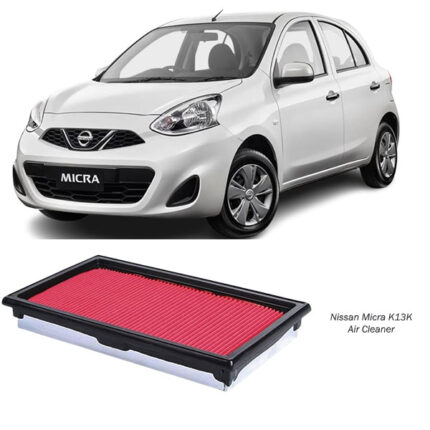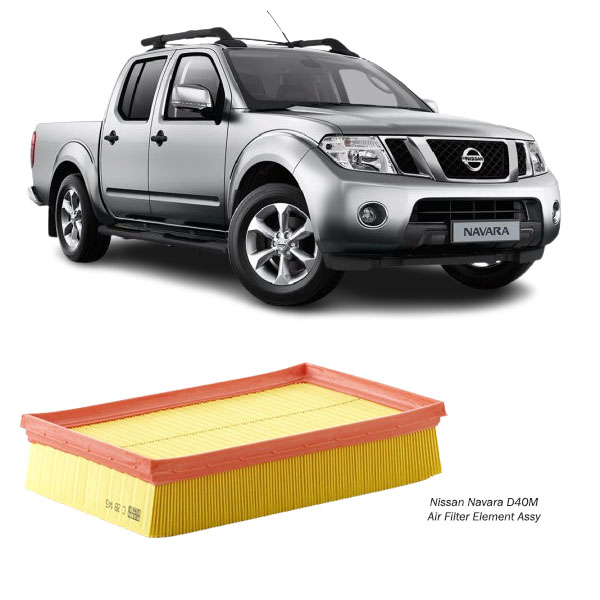Get Nissan Navara D40M Air Filter Element Assy 16546-EB300 in Kenya
The Air Filter Element Assembly is a crucial component of an engine’s air intake system. Its main function is to filter the air that enters the engine for combustion. Airborne particles such as dust, pollen, sand, insects, and debris can cause serious damage if they enter the engine. The air filter acts as a barrier, allowing clean air to pass through while capturing contaminants that could otherwise wear down internal components, compromise combustion, and reduce engine performance.
Typically housed in a plastic or metal air filter box, the air filter element is made of pleated material such as synthetic fiber, paper, or cotton. These materials are selected for their ability to trap tiny particles while maintaining smooth airflow. The assembly ensures the right amount of clean air enters the engine, maintaining the balance between fuel and air necessary for efficient combustion.
Advantages of a Good Air Filter Element Assembly
-
Engine Protection
A high-quality air filter prevents harmful particles from entering the engine. Even microscopic dust can cause significant wear on cylinder walls, pistons, and rings. By trapping contaminants, a good filter helps extend engine life. -
Improved Fuel Efficiency
Clean air is vital for the combustion process. An efficient air filter ensures the proper air-fuel ratio, which helps maintain optimal fuel consumption. When the engine gets the right amount of clean air, it burns fuel more effectively, leading to better mileage. -
Enhanced Engine Performance
A clean air filter allows unrestricted airflow into the combustion chamber. Adequate air intake means the engine can produce more power with less effort, improving acceleration and overall performance. -
Reduced Emissions
Engines running on clean air produce fewer unburned fuel particles. This results in lower hydrocarbon emissions and contributes to a cleaner exhaust, helping meet environmental standards. -
Smooth Engine Operation
Stable airflow provided by a good air filter contributes to smooth engine idling and consistent power delivery. It prevents hiccups, hesitation, or misfires often caused by restricted airflow.
Disadvantages of a Bad or Dirty Air Filter Element
-
Reduced Engine Power
A clogged or dirty air filter restricts airflow, causing the engine to work harder to breathe. This leads to reduced power output, sluggish acceleration, and poor throttle response. -
Increased Fuel Consumption
When the engine doesn’t receive enough air, it compensates by burning more fuel. This rich fuel mixture results in poor fuel efficiency and increased operating costs over time. -
Contaminated Engine Components
A damaged or overly dirty filter can allow unfiltered air into the engine. This may cause premature wear of vital components like valves, pistons, and cylinder walls, leading to costly repairs. -
Higher Emissions
Incomplete combustion due to poor air intake can increase harmful emissions such as carbon monoxide, hydrocarbons, and nitrogen oxides. This could lead to failed emissions tests or fines in regulated areas. -
Engine Misfiring or Rough Idling
Restricted airflow can affect the engine’s air-fuel mixture, leading to irregular combustion, engine misfires, and rough idling. This reduces the overall smoothness and reliability of the vehicle’s operation. -
Possible Engine Overheating
An overly rich fuel mixture caused by restricted airflow may raise combustion temperatures. Over time, this could cause overheating or additional stress on the cooling system.
Signs of a Worn-Out or Dirty Air Filter Element
-
Reduced Acceleration
If you notice a delay or reduced responsiveness when pressing the accelerator, it could indicate that the air filter is clogged and limiting airflow. -
Increased Fuel Consumption
A sudden drop in fuel efficiency may be a sign that the engine is compensating for a lack of clean air by using more fuel. -
Unusual Engine Sounds
A chugging, coughing, or popping sound from the engine bay, especially during acceleration, might indicate airflow restriction due to a blocked filter. -
Dirty Air Filter Appearance
Visual inspection often reveals the condition of the air filter. A clean filter is usually white or off-white. A blackened or heavily dust-coated filter should be replaced immediately. -
Check Engine Light
In modern vehicles, a clogged air filter may trigger the check engine light if sensors detect airflow imbalances or improper combustion. -
Rough Idling or Engine Hesitation
Irregular or rough engine idling and delayed acceleration can be symptoms of restricted air supply to the combustion chamber. -
Unpleasant Exhaust Smell
Incomplete combustion due to poor air intake can lead to the emission of unburned fuel, producing a strong, unpleasant exhaust odor.
How to Replace the Air Filter Element Assembly
Note: While replacement can be straightforward, it’s essential to follow correct procedures to avoid damage and ensure proper sealing.
Tools and Supplies Needed:
-
A new air filter element (ensure it’s the correct size and fit)
-
Screwdrivers (flathead or Phillips, depending on your air filter box)
-
Clean rag or vacuum for cleaning the air box
Step-by-Step Replacement Process:
-
Locate the Air Filter Housing
Open the hood and find the air filter box. It’s usually a rectangular or square black plastic container located near the engine and connected to the intake duct. -
Open the Housing
Release the clips, unscrew bolts, or unlock latches securing the air filter housing. Carefully open the cover and set it aside. -
Remove the Old Filter
Lift out the old air filter element. Inspect it for dirt, damage, or oil contamination. Even if it looks moderately dirty, replacement is often the best option for optimal performance. -
Clean the Filter Housing
Use a clean rag or a handheld vacuum to remove any dust or debris inside the air box. Avoid pushing dirt into the intake duct. -
Install the New Filter
Insert the new air filter element in the correct orientation. Ensure it fits snugly into the housing without any gaps around the edges, as these can allow unfiltered air into the engine. -
Re-seal the Housing
Close the air filter housing and secure all clips, screws, or fasteners. Make sure the lid sits evenly and firmly to prevent air leaks. -
Final Check
Start the engine and observe for a smooth idle. Ensure there are no unusual sounds or dashboard warning lights.
Follow us on Facebook for more parts.




